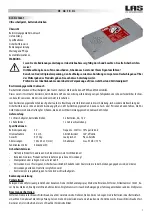
Troubleshooting
System failures are not always caused by the pressure reducing
valve. Most frequently:
1. Increased downstream pressure in the presence of a
water heater
If the downstream pressure
increases beyond the desired
setting due to an inline water
heater, install an expansion
tank between the pressure
reducing valve and the
water heater to absorb the
increased pressure, caused by
water expansion from heating.
2. The pressure reducing valve does not maintain
downstream setting value
If the pressure reducing valve does not maintain the downstream
setting, it most likely is due to impurities acccumulating on
the valve seat, causing unnecessary flow to pass-through,
increasing the downstream pressure. Proper maintenance
and cleaning of the removable cartridge is recommended.
Setting
Using a flathead screwdriver
turn the screw on top of
the plastic cover. Turn
it clockwise to increase
the pressure and counter
clockwise to decrease it.
PresCal
Compact
533H
series pressure reducing
valves are factory set to 45
psi (3 bar).
Application diagram
0
20
40
60
80
100
120
140
160
180
200
0
20
40
60
80
100
120
140
160
180
200
High risk of
cavitation
Normal operating
conditions
Out of normal
operating conditions
To minimize risk of cavitation, which can cause erosion in
the valve seal, and vibration and noise, refer to the operating
conditions noted in the above Caviation diagram. The ideal
upstream pressure to downstream pressure ratio is 2:1, and
no more than 3:1. For example, upstream pressure 80 psi,
downstram pressure 40 psi, pressure ration is 80/40, 2:1. Under
this condition the risk of cavitation is minimized. If the pressure
ratio is in the High risk of cavitation range (see above chart),
consider staging the pressure drop. For instance, break up a
large system pressure drop, such as 200 psi to 50 psi (4:1 ratio)
to 200 psi to 100 psi (2:1 ratio) for the first stage reduction,
and 100 psi to 50 psi (2:1 ratio). Secure the upstream and
downstream pipes with brackets per manufacturer instructions
and local requirements to avoid generating and transmitting noise
and vibration.
Cavitation diagram
Installation recommendations
Installation recommendations
1. Installation below ground
Installation below the ground is not advisable.
2. Outdoor installation
Pressure reducing valves should not be installed outside
the building unless properly protected from freezing and the
weather.
3. Water hammer
Water hammer is a common reason for pressure
reducing valve failures. Specific devices should be installed
to absorb water hammer for systems with this risk.
Upstr
eam pr
essur
e (psi)
Downstream pressure (psi)
Tamper-resistant cap:
The PresCal
Compact
533H series comes with a standard
gray snap-on cap which has a hole in the center to allow set
point adjustment using a flathead screw driver. Also included is
a black “tamper-resistant” cap, which can replace the
standard cap, to hide the adjustment screw thus
preventing set point tampering.
























